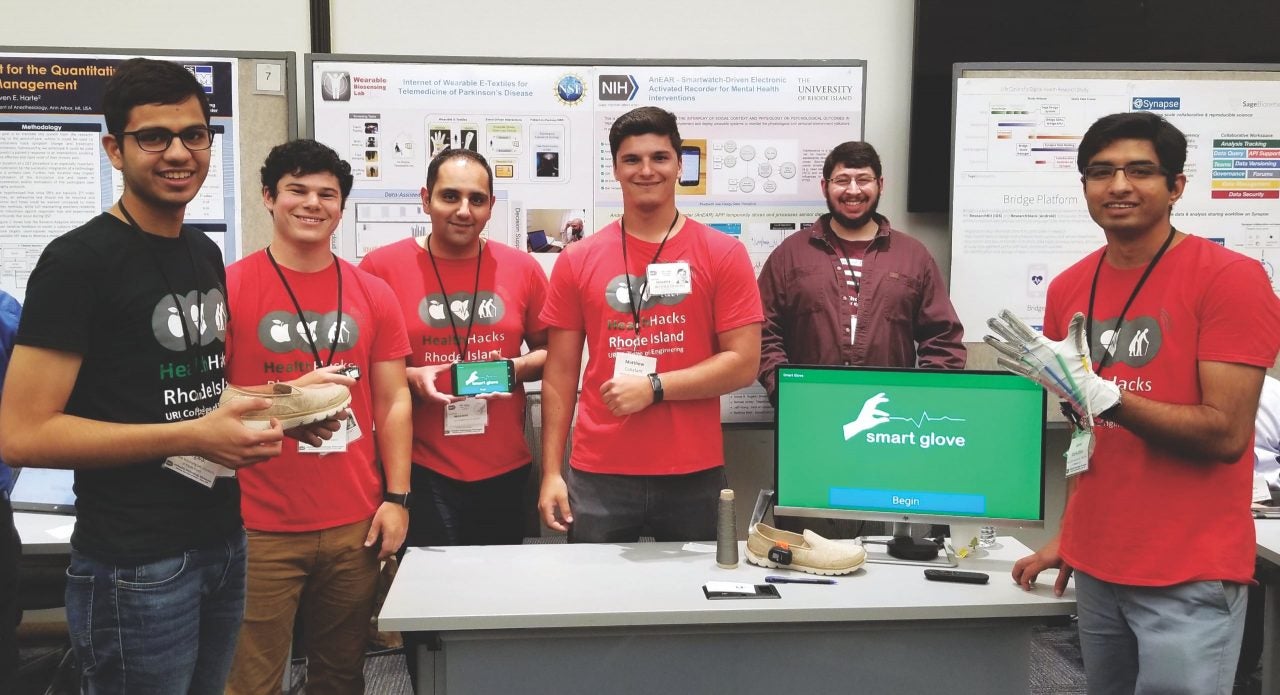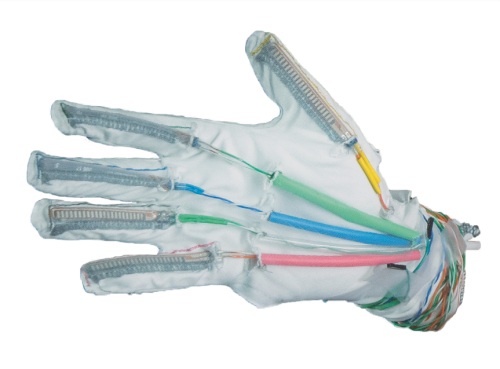Assistant Professor Kunal Mankodiya demonstrates his smart glove technology, which provides a user-friendly way for people with Parkinson’s disease to monitor symptoms and send the information to their doctors. Along with his research, Mankodiya is an active supporter of initiatives such as the annual “HealthHacks” design competition at URI to help students build their creative and entrepreneurial skills.
By Nicole Maranhas
Kunal Mankodiya is a collaborator, a team leader, a people person. Mankodiya and his students are developing wearable technology to monitor, treat, and help people with Parkinson’s and other medical conditions. Much of what they’re doing is unique, but perhaps the most notable thing about this team is that it is as focused on the people it’s designing for as it is on the technology itself.
For a cricket team, you need 11 players. This was a typical problem on Kunal Mankodiya’s mind as a teenager in the small town of Dhrangadhra, India, where as a team captain, he spent much of his free time going door-to-door rounding up enough players and strategizing how to use everyone’s strengths on the field. He never imagined a future in research, though he was a good student. Off the field, he frequently helped out at his family’s business, a clothing and textiles store in town. When it came time to apply to universities, Mankodiya’s curiosity was piqued by an unusual major in one course catalog—biomedical engineering—not only because he wasn’t sure what it was (“it was before Google,” he recalls), but also because there was only one university that offered it. “I figured it must be something new,” he says.
The three seem unrelated: cricket, a clothing store, biomedical engineering. For Mankodiya, a College of Engineering assistant professor who is breaking new ground in wearable technologies, they are interconnected keys to his success.
He remembers the morning inspiration struck. Over a cup of chai, Mankodiya was thinking about a smartwatch app he had developed with a neurologist during his postdoc research. Designed to help monitor the symptoms of Parkinson’s disease, a nervous system disorder that causes the progressive deterioration of motor function, the watch had potential for Parkinson’s treatment, but ultimately wasn’t ideal for capturing the data needed. As he sipped his chai, Mankodiya’s mind drifted to another past collaboration—a heart-monitoring belt he had developed while earning his Ph.D. at University of Lübeck in Germany. The belt had been designed to measure the heart’s electrical activity, an at-home electrocardiogram of sorts. It provided a more accurate reading than an in-office stress test—where a patient’s anxiety might skew results—and also could monitor heart activity over a prolonged period of time.
Mankodiya envisioned that a smart glove could enable patients to perform some of these tests at home, with a tablet or phone app to record data for their doctor to view remotely.
Perhaps in part because of his childhood days spent helping in his family’s store, smart textiles intrigued him. As he reflected again on the watch, Mankodiya wondered if a belt, or maybe a glove, would be a better way to measure Parkinson’s symptoms. Later that day, in his URI lab, he turned to his students and said, “Let’s begin a new project.”
Parkinson’s disease does not yet have a cure, but its symptoms, which include tremors, rigidity, and slowness of movement, can be helped by medication. However, to treat a person with Parkinson’s effectively, doctors must monitor symptoms closely, requiring regular office visits for patients to perform exercises such as finger- tapping, fist-opening and closing, and foot-stomping to measure how well the medications are working. Mankodiya envisioned that a smart glove could enable patients to perform some of these tests at home with a tablet or phone app to record data for their doctors to view remotely. It would save them trips to the doctor’s office and also make it easier to monitor symptoms on a daily basis over an extended period of time—key for a disease like Parkinson’s, where decline happens gradually. Working with his students, he devised a glove prototype and brought it to neurologists Umer Akbar and Joseph Friedman at Butler Hospital in Providence, Rhode Island, who were enthusiastic about its potential. “When neurologists think your work is interesting,” Mankodiya says, “it’s an exciting moment.”
Since then, his ongoing collaboration with the neurologists has evolved to include other wearables for people with Parkinson’s—including socks, insoles, and, most recently, a trouser that monitors factors such as gait and balance. “One of the difficulties in treating people who have Parkinson’s disease is that their symptoms vary throughout the day, sometimes in ways that they’re unable to report,” says neurologist Akbar, citing as an example the dyskinesia—involuntary, uncontrolled movement—that sometimes causes falls. “It is well-known that these movements are often underrecognized and underreported by patients, and if that is the case, the problem goes untreated. Wearable textiles can help bridge the gap between patient and clinician.”

The neurologists are key players on an impressive team. URI faculty in engineering, textile design, kinesiology, nursing, and the Ryan Institute for Neuroscience, and specialists and organizations outside URI are among the lab’s collaborators on various in-the-works or upcoming projects. Among them: smart shoes to help detect gait abnormality linked to dementia, wearables for stroke rehab, and even mattress toppers for sleep monitoring. But the collaborators always foremost on Mankodiya’s mind are the people who will use the wearables and the students at the heart of his work.
Several times a year, Andrea Hopkins ’68 makes a trip to the Wearable Biosensing Lab. There she works with Mankodiya’s team, giving feedback on the comfort, practicality, and wearability of their designs and serving as a first tester of new prototypes. Diagnosed with Parkinson’s in 2002, Hopkins—who is a former assistant vice president of public affairs for URI—says of her collaboration with Mankodiya’s lab, “I can’t change the diagnosis, but I can make the best of it by working with those who are trying to help.” Hopkins is also a member of Associate Professor Leslie Mahler’s speech therapy group for people with Parkinson’s, and works regularly with URI’s physical therapy department—two other resources she considers “a godsend” in staving off the progression of the disease. “There’s no cure, but medication and exercise can help,” Hopkins says. “If the students see how their work helps people like me, I hope it encourages them to continue.”

The students certainly continue. Undergrads in Mankodiya’s popular Wearable Internet of Things (ELE 491/ELE 591) course have devised wearables including a baby onesie to treat jaundice (created by Joshua Harper ’18 and James Baez ’18) and a bionic hand to help stroke victims regain movement (Mary Ellen Sweeney ’18, Tian Chen ’18, and Scott Barlow ’18), to name just two. In the course, students from various disciplines create wearable technologies and tap into their inner entrepreneurs; some even market their designs. “If we give students freedom and don’t spoon-feed them, they feel ownership,” Mankodiya says. “They ask questions, they suggest new ways to think about things. Without that, we won’t change the paradigm of smart textiles.”
Nick Constant ’15 has worked with Mankodiya since 2014, when he was a senior embarking on his capstone project. Now working toward his Ph.D., he credits advisor Mankodiya for instilling in students a passion for using technology to help others. “The goal isn’t making technology that does things for a person,” says Constant. “It’s helping people to do things for themselves.” Beyond the cool factor of the lab’s work, Constant notes an overarching emphasis on community outreach—evident in how often Mankodiya and his students can be found outside the lab: helping to organize hackathons, making paper circuits with local middle-schoolers, giving family-friendly demos at the annual URI Brain Fair, and hosting incoming first-year students for a one-day crash course in coding and design. “It’s not always common for an engineer to be a people person,” observes Constant. “Kunal is a people person.”
Right now, the glove is a poly-cotton blend. Neoprene might work better, Mankodiya notes, ever experimenting. Comfort and flexibility are only two of the design considerations behind a wearable, which must deliver precise results consistently. Some wearables require delicate sensors; others must withstand pressure. Placement is key, as is stability. Hygiene is a factor—the textile will require frequent use and ultimately multiple users. “Each human is different, each hand or foot is unique,” says Mankodiya. “You need to create something that is personalized, yet is also for many people.” Above all, it must be something the wearer will want to use.
“Each human is different, each hand or foot is unique,” says Mankodiya. “You need to create something that is personalized, yet is also for many people.” Above all, it must be something the wearer will want to use.
In many ways, Mankodiya is still grounded in the lessons he learned at his family’s clothing store, where pleasing the customer meant paying attention to the individual’s needs. In other ways, he’s ever the cricket captain, rounding up teammates and strategizing how to maximize their on-field strengths. As he gains increasing attention for his innovative work—he recently helped establish URI’s Artificial Intelligence Lab, which opened in fall 2018 —it seems his story is still only beginning—the one that began with a teenager who became curious about biomedical engineering simply because he couldn’t fathom what it was. “Our neighbor, who was a doctor, explained that it meant creating medical devices,” Mankodiya recalls. “I could only imagine stethoscopes, but I thought I’d give it a try.”

